
MAY CONTAIN NUTS

Search Shorpy
SHORPY ART

Framed or unframed, desk size to sofa size, printed by us in Arizona and Alabama since 2007. Explore now.
Join and Share
Ad-Free Shorpy
Shorpy is funded by you. Patreon contributors get an ad-free experience.
Learn more.

Recent comments
- Baldwin 62303
- Baldwin VO-1000
- Cold
- No expense spared
- Tough Guys
- Lost in Toyland
- And without gloves
- If I were a blindfolded time traveler
- Smoke Consumer Also Cooks
- Oh that stove!
- Possibly still there?
- What?!?
- $100 Reward
- Freeze Frame
- Texas Flyer wanted
- Just a Year Too Soon
- WWII -- Replacing men with women at the railroad crossing.
- Yes, Icing
- You kids drive me nuts!
- NOT An Easy Job
- I wonder
- Just add window boxes
- Icing Platform?
- Indiana Harbor Belt abides
- Freezing haze
- Corrections (for those who care)
- C&NW at Nelson
- Fallen Flags
- A dangerous job made worse
- Water Stop
Member Photos
The Shorpy
Print Emporium
Print Emporium
Search Shorpy
Search results -- 30 results per page
- Five Little Naons: 1912
- "Naon children, 1912." Romulo Naon Jr., son of the Argentinean ambassador, and siblings. I ... will spend the summer.
Washington Post, May 19, 1912
My new favorite picture This replaces the picture of ... if any of them did end up staying in the United States? 1912 would have been a part of Argentina's glory years, when iy was one of the ... Posted by Dave - 08/13/2012 - 6:09pm -
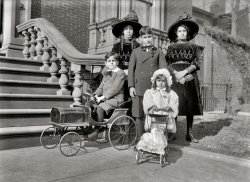
- Chelsea Piers: 1912
- New York, 1912. "New Chelsea Piers on the Hudson." Feast your eyes on this veritable ... closed to Liverpool, aboard the Lusitania, in December, 1912.
Drafting - the old way! My eyes, too, were drawn to the top floor ... or exit the yard. If there is a clock in view, a date in 1912 for the photo, a streetcar schedule and some streetcar records still ... Posted by Dave - 01/15/2024 - 3:02pm -
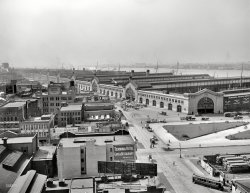
- Southern Accents: 1912
- ... (at the right of the main picture) A coquina veneer in 1912 tied them together. The original portion burned in 1932 - Who'd have ... Posted by Dave - 02/18/2024 - 12:40am -
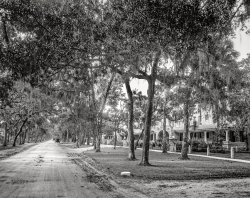
- Flyboy: 1912
- 1912. "Army aviation, College Park. Tests of Curtiss plane for Army. Single ... there is evidence that Milling flew at College Park in 1912. More on the history of army aviation at College Park at the College ... service department.
Washington Post, Jul 28, 1912
Army Men Soar High
Milling's Second Successful ... Posted by Dave - 07/21/2012 - 3:29pm -
![Flyboy: 1912 1912. "Army aviation, College Park. Tests of Curtiss plane for Army. Single control." Harris & Ewing Collection glass negative. View full size.
Re: StrutsIt is bamboo, the stuff has good strength for its weight. Those airplanes were glorified box kites with a not particularly powerful engine lashed on.
StrutsTell me that isn't bamboo.
Bamboo!Looks like a real strut of bamboo connected to the wheel and probably to the elevator control surface! Bamboo is really strong, however.
[Kind of a built-in shish kebab skewer in case of a crash. - Dave]
Nice FlowerpotNot only have airplanes evolved over time but so have the crash helmets.
Lieutenant MillingThis looks to be the same Lt. Milling pictured in a two seater here, though now he has a plane of his own.
Thomas Dewitt MillingThe pilot looks so young! As the Anonymous Tipster suggests, he does appear similar to Lieut. Thomas ("Tommy") Dewitt Milling, and indeed there is evidence that Milling flew at College Park in 1912. More on the history of army aviation at College Park at the College Park Aviation Museum, the National Park Service, and the College Park Airport.
Wireless From Aeroplane
Lieut. Milling Sends Message From Machine to Field Station
Lieut. Thomas Dewitt Milling and George W. Beatty, the aviator, starred in tests of the new type C Wright aeroplane at the army aviation school at College Park, Md., yesterday. It was a day of much activity. Flights started before 7 o'clock in the morning and lasted until sunset.
...
One of the most brilliant of the performances was that of Lieut. Milling. Carrying a wireless instrument weighing 70 pounds in a cross-country flight, he sent messages to the wireless station on the aviation field. The feat was attempted on the orders of the wireless service department.
Washington Post, Jul 28, 1912
Army Men Soar High
Milling's Second Successful Flight at College Park.
Soaring to the height of 1,300 feet at 6 o'clock yesterday afternoon, Lieut. Thomas DeWitt Milling, of the army aviation school, completed the last of two successful flights which he has made at College Park. Several other flights were made in preparation for the Labor day celebration at Benning tomorrow.
Washington Post, Sep 1, 1912
Air Scouts Contest Today
Army Fliers to Compete for the Clarence H. Mackay Trophy.
A competitive test in aerial reconnaissance work by army aviators is to be held today, and the winner will receive the Clarence H. Mackay trophy.
Starting from College Park early this morning, Lieuts. Roy Kirtland, Henry H. Arnold, and Dewitt Milling, of the aviation corps, will carry sealed orders directing them to locate and report upon the approaching "enemy." the closeness with which the aviators approximate the character, size and location of the various divisions of the sham opposing army; also the proximity of their landing to their starting points, and the character of their landing will be counted in the awarding of the prize.
Any flier who operates at a height of less and 1,000 feet will be disbarred, such recklessness being considered suicidal in time of war. This will be the first time in Mackay trophy has been competed for. Hereafter, however, annual competitions will be held.
Washington Post, Oct 9, 1912
Answer to Un-asked QuestionTo answer the question which was asked of a previous shot of a Curtiss aeroplane, the strap running over the pilot's shoulders and onto the padded bar was not an early seat belt, although it may have functioned as such somewhat. It was in fact connected to the rudder, so that the pilot turned the wheel(ailerons) and swayed his torso to achieve coordinated turns. The current system of foot pedals for rudder control wasn't agreed upon ontil the Curtiss JN4-D Jenny), I believe.
Hap ArnoldLt Henry H. Arnold, known as "Hap", had an impressive military career. He was Military Aviator number 2, Chief of Staff of the Army Air Forces during WWII ("the big one" as Mr Gillis used to say), General of the Army and General of the Air Force (5 stars). He was also responsible for what later became Rand Corporation.
That's the thing about second lieutenants...you never know what will become of them until much later.
Are We Not Men?We are DEVO!
HelmetsThe wacky helmet is a direct result of 1st Lt. Thomas Selfridge. He was the first armed forces aviator to die in a plane crash. It is speculated that had he lived, Selfridge would have become an aviation marvel.
That helmet. Would be of great protection on any kind of frontal collision. Particularly from the large engine and radiator sitting directly behind you.
Happy 100thAugust 29, 2009, the College Park Airport is celebrating its 100th birthday.
Curtiss Model D 1911A shoulder yoke was used to twist the wing for turns. The "tail" was out in front. The 1911 Curtiss Model E had the empennage mounted in the rear and had the first ailerons. "the character of their landing will be counted in the awarding of the prize." Meaning an award to the pilot that didn't convert one of Uncle Sam's prized kites into kindling on landing.
(The Gallery, Aviation, Harris + Ewing)](https://www.shorpy.com/files/images/01482a_0.thumbnail.jpg)
- World Series: 1912
- ... Professional. Crowds at scoreboard." Watching the 1912 World Series courtesy of the Washington Post on an electro-mechanical ... the roadster but where is it in this photo?
[In 1912 Mr. Foster's shop was on 14th Street across from the Willard (ad below from December 1912). The store in the 1924 photo, when he had two locations, might be the one ... Posted by Dave - 09/11/2011 - 8:24pm -
![World Series: 1912 "Baseball, Professional. Crowds at scoreboard." Watching the 1912 World Series courtesy of the Washington Post on an electro-mechanical scoreboard that looks something like a big pinball game. In the years before the first radio broadcasts in the early 1920s, newspapers, linked to reporters by telephone, wire service or "wireless telegraph," provided live coverage of sporting events like prizefights and baseball games to crowds on the street, with announcers and scoreboards giving play-by-play results. Harris & Ewing Collection glass negative. View full size.
Men without hatsI see two!
The WillardI'm a little confused looking at this photo. I know that the Washington Post was once on E St. just north of what is now called Freedom Plaza. And there was a Hotel Johnson at 13th and E, which would be consistent with the idea that this is shot looking east down E Street from about 14th Street.
But I'm confused because the building looming in the background looks like the Willard, which would be behind the camera if I'm right. Was there a building at 12th and Pennsylvania that looked exactly like the Willard?
[Update: We are looking down E Street at the Raleigh Hotel. - Dave]
Officer! Arrest That ManYou there! Without a jacket or a hat. Come with me. You are under arrest as either a vagrant or a visitor from the future - and with those suspenders and bow tie, the latter is obviously not the case.
E StreetI think that this view is indeed looking eastward along E street. At some point, Mr. Foster's shop moved, a careful study of the buildings show that they are different. An alternative view of some of the buildings, and the "Velvet Kind" sign, is seen in the nighttime Washington Noir photo.
The 1400 block of E street is visible in the background of one of the many views of the Hayes roadster. But this puzzles me. The National Theater building, with the blocky projecting bays, is perhaps seen in both. However, the Munsey Building, the large white block built in 1905, is seen behind the roadster but where is it in this photo?
[In 1912 Mr. Foster's shop was on 14th Street across from the Willard (ad below from December 1912). The store in the 1924 photo, when he had two locations, might be the one at 1229 Pennsylvania Avenue. In any event, that's the Raleigh Hotel in the background. The cupola was at 12th and Pennsylvania, so this would indeed seem to be E Street. - Dave]
Update: There is a reference in the Post in 1908 referring to address of National Remembrance Shop at 1333 E street. The Historical Society of DC has an image of the corner of 14th and E showing Mr. Foster's at the 503 14th site. Note the trusty policeman directing traffic in the foreground.
Washington Post, Apr 26, 1914
The Munsey Trust Company yesterday bought the property at 1335 E street, occupied by William A. Engel, who conducts a saloon, bowling alley, and restaurant. The purchase of the property gives the Munsey Trust Company ownership of all the buildings and ground between the New National Theater and the Washington Post building.
The trust company announced that an eleven-story office building is to be built on the site now occupied the by Shoomaker company and Engel, to adjoin the Munsey building. The new building will be of the same height as the Munsey building, and will be surmounted by a tower. The entrance of the present Munsey building will be changed. Work on the new building will begin June 1. McKim, Mead & White, of New York, will draw the plans for the building.
So I take from this, that the large columns in this photograph are the entrance to the original Munsey building. when the building was expanded The facade was rebuilt to the appearance seen in the roadster photo. This suggests the roadster photo was probably taken after 1915.
The World Series is the Big EventThe best thing of all is that this crowd is gathered on a Washington street to watch the results of a World Series played by franchises in two other cities.
Subway SeriesThere was a time, before TV sets were common in homes, that people would gather in front of stores that sold them. In most NYC neighborhoods, they were radio repair shops. There they watched the telecasts the same way the folks in this picture watched the scoreboard, but the crowds were nowhere as large as this. However, in the 1940's and 50's there was local interest because the Yankees, Giants (NY that is) and/or Dodgers (Brooklyn, that is) were usually in the series.
VarietyEven though a casual glance reveals a sea of derbies and homburgs, careful examination reveals quite an interesting variety of hat styles and "bashes" (crown shapes).
(The Gallery, D.C., Harris + Ewing, Sports)](https://www.shorpy.com/files/images/01551a.thumbnail.jpg)
- The Old Ball Game: 1912
- October 8, 1912. First game of the 1912 World Series, between the New York Giants and Boston Red Sox. Right field ... a hat in that photo. By the way, this is a great blog.
1912 World Series I found Waldo!
Kind of surprised I notice that the ... Posted by Dave - 07/23/2012 - 6:41pm -
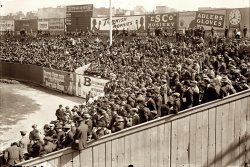
- Higher Powers: 1912
- New York circa 1912. "Broadway and Trinity Church." In the distance, the Singer and Woolworth ... negative. View full size.
Oh to be a milliner in 1912 I walked in that exact spot 99 years later, in the spring of 2011, ... There were similar throngs of people but, whereas in 1912 most people were normal weight and possessed of significant sartorial ... Posted by Dave - 10/16/2019 - 8:53pm -
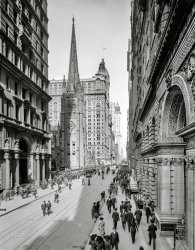
- Copley Plaza: 1912
- Boston, Massachusetts, circa 1912. "Copley Plaza Hotel, Copley Square." 8x10 inch dry plate glass negative, ... black-on-white license plate on the cool roadster is a 1912 Rhode Island dealer's license number 1. Collectors would pay four-figures ... Anyway, I finally spy a pigeon on the grass in front!
1912 Rhode Island License Plate Number 1 1912–17
Black numbers on white ... Posted by Dave - 01/05/2019 - 1:44pm -
![Copley Plaza: 1912 Boston, Massachusetts, circa 1912. "Copley Plaza Hotel, Copley Square." 8x10 inch dry plate glass negative, Detroit Publishing Company. View full size.
Tag on that "cool roadster"That black-on-white license plate on the cool roadster is a 1912 Rhode Island dealer's license number 1. Collectors would pay four-figures for that today.
That Car!What make is that automobile in the foreground? It almost looks like an early model Jeep. I wonder if any Shorpy fan can identify it and what year it was manufactured?
Granddad worked hereUntil his passing in 1960, my grandfather was maître d' in the Merry-Go-Round Room on the first floor just inside the righthand entrance. The lounge closed for a day in his honor.
This grand old lady still stands.
Still there todayPretty much everything else is gone, 'cepting the BPL (behind the trees) and Trinity Church (behind the photog).
Cool roadsterI love the car at the curb. Probably hard to identify it here, and the bolt-on split windshield is something I've never seen before in my 40+ years in the antique car hobby.
[That's some sort of fabric snap-on shroud. - Dave]
Found a bird!I’m always trying to spot birds in these old photos whether they are in trees, on wires or on buildings. I have yet to find many in my several years of looking. I think Dave said it was mostly due to shutter speed? Anyway, I finally spy a pigeon on the grass in front!
1912 Rhode Island License Plate Number 11912–17
Black numbers on white porcelain plate;
Design .............. vertical "RI" at left
Slogan .............. none
Serial format ...... 12345
1 to approximately ... 35000
Rhode Island reused numbers from earlier expired registrations. The reason being they did not want to exceed the 99,999 numbering scheme limit. They did exceed that limit in 1913.
That said, this is the first 1912 registration. suggesting the auto is 1912 or earlier vintage.
The auto at the curbOut on a limb. It looks like the 1912 Thomas Flyer Model MC 6-40 Roadster. radiator and spare tire mounts are similar.
Cambridge FrontThe leatherette and isinglass windshield supported by brass rods was most likely made by a company in Cambridge, Massachusetts. Known as "Cambridge Windshields," they were mostly used on sporting type cars.
Also note that the car appears to have Rhode Island license plate number 1.
(The Gallery, Boston, Cars, Trucks, Buses, DPC)](https://www.shorpy.com/files/images/SHORPY-4a24556a.thumbnail.jpg)
- Bike Shop: 1912
- Detroit, Michigan, circa 1912. "Metzger bicycle shop. Detroit City Gas Co." This photo of a cycle (and ... with two wheeled vehicles, apparently!
The 8-track of 1912 Those shelved items on the right are music cylinders. Music discs were a growing market in 1912 but looks as if this shop's owner had a lot of inventory to move before he ... Posted by Dave - 08/13/2013 - 4:13pm -
![Bike Shop: 1912 Detroit, Michigan, circa 1912. "Metzger bicycle shop. Detroit City Gas Co." This photo of a cycle (and phonograph) shop was taken to show off the gaslight fixtures. 8x10 glass negative, Detroit Publishing Company. View full size.
MotorcyclesI see four motorcycles on the left. An Excelsior Autocycle (Ignaz Schwinn was behind Excelsior motorcycles). Behind the Excelsior is a "camelback" Indian of about 1909 vintage, I think. Then another Indian and perhaps another Excelsior. In today's market those old motorcycles would extremely valuable and sought after by collectors. I think music, bicycles, and motorcycles would still make for a fun shop today.
RiddleWhat do gramophones and bicycles have in common? No, seriously, I want to know.
[Horns. - Dave]
Flash!Is that the reflection of the magnesium flash going off behind the men?
[It is! - Dave]
Huber & MetzgerBill Metzger started the first retail automobile store in Detroit in the old Biddle house. He became the first independent auto dealer in Detroit and probably the US. Below, the Huber & Metzger bike shop at 13 Grand River Avenue.
A hipster's dreamWhat beautiful bikes. As a cyclist, I would love to have one of them.
Just like today's hipster bikesNo brakes - no coaster brakes, no hand brakes.
All the with-it college kids are riding fixed gear bikes with no brakes these days.
Safety third!
FixiesAs far as I can see, none of the bicycles on offer have any brakes whatsoever. Such carefree times.
Well that's puzzlingI don't see any light fixtures that look like gas burners. I'm not aware of any glass bell shades pointing down that were ever used on gas lights. I'm pretty sure I can see bulb sockets on the perimeter lights, although I can't quite make them out. The fixtures in the center of the room have pull-chain switches on them.
[Each gas chandelier has a pair of pulls to regulate flow. Below is another example from Detroit City Gas Co. - Dave]
An Odd MixThe left side of the shop has a good selection of Victor Talking Machines. The right wall has shelves of Edison cylinders . I think I see a Columbia at the back of the shop. And all those bicycles! What a combination.
Mail CallI'd say those envelopes, in the showcases behind the Victrolas, hold recordings by John McCormick, Enrico Caruso, Rosemary Clooney and Elvis.
Early ironSome of those "bikes" are motorcycles.
Not all are bicyclesI spot at least two Indian and two Excelsior Auto Cycles on the left row and can't quite identify what is in back behind the two men sitting though I suspect another Excelsior.
All NaturalNot single black tire in the shop. Everything is natural rubber.
The sound of bikesI find it quite amusing that the two leading bicycle store chains in Israel, where I live, are called Matzman and Mintz. Something with the "TZ" sound drags people to deal with two wheeled vehicles, apparently!
The 8-track of 1912Those shelved items on the right are music cylinders. Music discs were a growing market in 1912 but looks as if this shop's owner had a lot of inventory to move before he could think about selling discs. (Judging by their loose-looking packaging, I don't think the items in some sort of vertical envelopes on the shelves on the left are discs, although if they are, they're way outnumbered by the cylinders.) Some of the songs of the day: "She Pushed Me Into the Parlour," "Daddy Has a Sweetheart (And Mother Is Her Name)," "Ragtime Cowboy Joe," "When Irish Eyes Are Smiling," "The Sweetheart of Sigma Chi" and Irving Berlin's "Keep Away From the Fellow Who Owns an Automobile."
Used MotorcyclesIt seems that these fellows dealt in used equipment as well, Indian Motorcycles produced the last Camelback gas tank single cylinder machine in 1908 (according to my father, who's the curator of a very large motorcycle museum). The Metzger Bicycle Concern would have a heart attack if they knew what that "old" Indian single was worth today.
[This picture could just as well be from 1908. - Dave]
Metzger Got AroundBill Metzger was also behind the Metz car, which has previously been a Shorpy subject. I learned that from a friend who I had sent this photo to.
Gas and ElectricThe center fixtures are gas, but the perimeter fixtures are electric. Best of both worlds when electric lighting was not necessarily bright or reliable.
Obsolete Stock The items on the left-hand shelf are most likely Victor records. Victor & Edison allowed their dealers to carry both lines, until Edison introduced a disc machine & Victor ordered its dealers to drop Edison.
All of the cylinders appear to be 2 minute records, although Edison introduced the 4 minute "Amberol" cylinder in 1908. Both were about to be discontinued in late 1912, along with open horn machines. The celluloid "Blue Amberol" record and a new line of Amberola (inside horn) cabinet machines were introduced in the Fall of 1912. Dealers were then allowed to discount the 'wax' cylinders, to clear their stocks.
By this time, Edison's consultants said people were "Victrola crazy", while Edison's cylinder business fell disastrously & Columbia quit cylinders altogether.
Bicycles & gramophonesIt's what they don't have in common that matters. Bicycles sell well in warmer months when people are outdoors. Gramophones sell well in colder months when people are indoors. I believe this is Metzger's shop at 351 Woodward and not the one he shared with Huber.
http://www.m-bike.org/blog/2010/12/11/metzger-bicycle-shop-in-1912/
(The Gallery, Bicycles, Detroit Photos, DPC, Motorcycles, Stores & Markets)](https://www.shorpy.com/files/images/4a26689a.thumbnail.jpg)
- Higher Lower Manhattan: 1912
- New York circa 1912. "Big buildings of Lower Manhattan." Notable skyscrapers (in a scene last ... and the Bankers Trust pyramid. View full size.
1912 -> 1917 image flip Image flip between 1912 and 1917, perspective adjusted to align. Things change mighty fast around ... Posted by Dave - 01/04/2017 - 1:19pm -
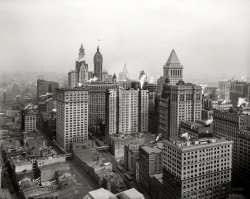
- Main Street USA: 1912
- Circa 1912. "Main Street and Chippewa Hotel, Mackinac Island, Michigan." 8x10 inch ... now my wife.
I'd put this earlier than 1912 If this were ca. 1912 I think we'd see an automobile or two on the street. Judging by the ... Posted by Dave - 07/27/2018 - 1:20pm -
![Main Street USA: 1912 Circa 1912. "Main Street and Chippewa Hotel, Mackinac Island, Michigan." 8x10 inch dry plate glass negative, Detroit Publishing Company. View full size.
+103Below is the same view from August of 2015.
Somewhere in Time!Photo from the very year in which the movie was set.
No luck spotting Elise and Richard, though.
A favorite of the woman who was then my girlfriend, now my wife.
I'd put this earlier than 1912If this were ca. 1912 I think we'd see an automobile or two on the street. Judging by the women's clothes, I'd put it earlier, somewhere 1895-1905.
[You are obviously new to Mackinac Island, famous for being where cars are verboten. Also, count the stars on the flags. There are 48. - Dave]
ColorfulIf this isn't a colorized photo waiting to happen, I don't know what is.
Somewhere elseMackinac Island does feel like it's somewhere (else) in time. It may be because so many of its buildings are still there.
The multi-gabled Chippewa Hotel is on the left, still open every summer. At least the first 4 buildings on the right are still there, but the steeple is gone from the third building.
We remember it fondly because we honeymooned there, well after the season in December; we were the only people in the hotel for a while.
Still smell the horsesNo motorized traffic allowed on Mackinac Island to this day.
What the hackis "bric a brac"?
(The Gallery, DPC, Horses, Stores & Markets)](https://www.shorpy.com/files/images/SHORPY-4a24672a.thumbnail.jpg)
- Apartment 17: 1912
- January 1912. New York. "Basso family, 2 Carmine Street, Apt 17. Making roses in dirty, ... the brewers' guild in Germany. - Dave]
Apartment 17: 1912 This is Joe Manning, of the Lewis Hine Project. I did some quick ... (on 1910 Census), either died or skipped town between 1912 and 1915 as the mother Columbia is shown as the head of household in 1915. ... Posted by Dave - 09/30/2012 - 4:09pm -
![Apartment 17: 1912 January 1912. New York. "Basso family, 2 Carmine Street, Apt 17. Making roses in dirty, poorly lighted kitchen. They work some at night. Pauline, 6 years old, works after school. Peter, 8, works until 8 p.m. Mike, (cross-eyed), 12 years old, until 10 p.m. Father keeps a rag shop." Photo by Lewis Wickes Hine. View full size.
A million barrels of beer on the wallIn late 19th century New York City, George Ehret was its most successful brewer, and the partly obscured line on the calendar page bottom (“1,000,000 barrels sold every year”) was no empty brag. He made a trip to Germany during the First World War, couldn’t get back to the U.S., and the government, caught up in anti-German actions, seized his business. When he managed to return, he worked to straighten everything out, and sponsored a number of pro-American ads for War Bonds. Here's a calendar similar to the one in the Basso home. (Note the Star of David incorporated in the company logo. He might not have made it out of WW II Germany.) What the war couldn’t do to Ehret’s business Prohibition did; the company floundered and in 1935 was bought by the Jacob Ruppert Brewery, also in New York.
[That "Star of David" -- the hexagram or Bierstern (beer star) -- is a symbol of the brewers' guild in Germany. - Dave]
Apartment 17: 1912This is Joe Manning, of the Lewis Hine Project. I did some quick research this morning. In the 1940 census, Mrs. Basso (first name Columbia) was a widow, and lived in NYC with three sons, John (50), Michael (40) and Peter (36). John is not in this picture, but Michael and Peter are. John was working, oddly enough, as a flower dyer. Michael was a trucker, and Peter worked in a print shop. Michael died in New Jersey in 1986. I could find no certain death records for John, Peter or Pauline. I hope I can find more when I get time.
This kitchenlooks neither particularly dirty or poorly-lit for the standards of the day. The room is humble but it looks fairly clean to me, especially considering the activity they're engaged in.
[The magnesium flash took care of the lighting. - Dave]
Jacob Rupert BreweryThe Rupert Brewery, brewers of Knickerbocker Beer, took over the Ehret's Brewery in 1935. Col. Rupert, of the beer company, also owned the NY Yankees. The Brewery was torn down around 1965 and the Rupert Houses, a group of high rise residential buildings was built shortly after that.
Last CallAs a footnote to a footnote, a recent Streetscapes column in the New York Times outlined the rise and fall of Ehret's Brewery. It was demolished in 1969 for an apartment complex. The clock tower pictured in the calendar was intended to be saved, but wound up being destroyed by vandals.
To Joe ManningThis is the first chance I've had to mention seeing you on the CBS Evening News last week. The item Seth Doane did on you and your work with the Lewis Hine photos was excellent, and the interview with Mamie La Barge's granddaughters gave the topic a sense of relevance.
The video can be found here.
2 Carmine St.I'm guessing this is what 2 Carmine looks like from the outside today:
View Larger Map
Maxfield Parrish CalendarI always enjoy seeing these in old photographs. His art was ethereal
The Basso Family through the yearsFollowing up on Mr. Manning's post, I can see the Basso Family on the 1910, 1920 and 1930 US Census. Also on the 1915 NY State Census.
The original family in 1910 was: Antoine (father), Columbia (mother), John (20), Antoinette (14), Michael (10), Edith/Aida (9), Peter/Pietro (7) and Pauline (4).
1915: The father, Antoine (on 1910 Census), either died or skipped town between 1912 and 1915 as the mother Columbia is shown as the head of household in 1915. All sibs are still there at 2 Carmine St.
1920: Antoinette is gone so she either married or died between 1915 and 1920. Probably married as she was in her 20's. Everyone else is still there, but they have moved to 28 King Street which is a few blocks south of Carmine.
1930: Edith is gone so like Antoinette she either married or died between 1920 and 1930. Left are Columbia, John, Michael, Peter and Pauline.
I couldn't find anything on Pauline after 1930.
Clock WorksThe clockworks from the Ruppert Brewery survives today at Pratt Institute in Brooklyn. The tower may be gone, but the works are still with us.
(The Gallery, Kids, Lewis Hine, NYC)](https://www.shorpy.com/files/images/SHORPY_05486u.thumbnail.jpg)
- He Sells Celery: 1912
- April 1912. 10:30 p.m. at Center Market in Washington, D.C. Eleven-year-old celery ... full size. Photograph by Lewis Wickes Hine.
apr. 1912 wow. this picture was taken the same month the Titanic sank. amazing. ... Posted by Dave - 09/08/2011 - 5:28pm -
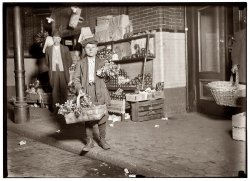
- Cleveland: 1912
- Cleveland, Ohio, circa 1912. "U.S. Post Office, Custom House and Court House, Public Square." 8x10 ... to scoot?
Cars 23, horses 1, pushcarts 1 It's just 1912, but the competitive battle between four-hoofed and four-wheeled ... Posted by Dave - 11/12/2023 - 12:37pm -
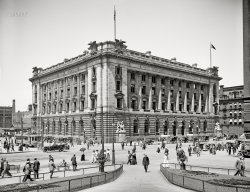
- Billy and the Giant: 1912
- June 27, 1912. Rye, New York. "Wells & Coffey." English heavyweight champion ... cruiserweight, not even a heavyweight.
Bombardiers of 1912 When I saw this, it made me curious. I've always thought of a ... job was to get the bombs on the target. Obviously, in 1912, the title could not have referred to anything much like that.
I ... Posted by Dave - 01/18/2013 - 3:20pm -
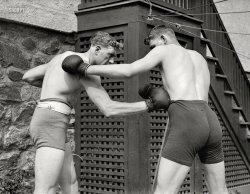
- The Pontch Again: 1912
- Detroit, Michigan, circa 1912. "Hotel Pontchartrain." Yet another view of this relatively short-lived ... Posted by Dave - 11/08/2023 - 5:20pm -
![The Pontch Again: 1912 Detroit, Michigan, circa 1912. "Hotel Pontchartrain." Yet another view of this relatively short-lived hostelry on Woodward Avenue, whose downfall was a paucity of private bathrooms. Familiar landmarks include the Soldiers' and Sailors' Monument, Cadillac Square and the Cadillac Chair. 8x10 inch glass negative, Detroit Publishing Company. View full size.
"Misfit"I wonder what went down at "MISFIT"? Or did they just sell irregular clothing? And what could those fellas on the corner be taking a gander at?
[Misfit was the haberdashery owned by Sol Berman at 120 Woodward Avenue. The headline below is like something out of the Onion. - Dave]
Anywhere you wantThere do not seem to be much in the way of parking regulations yet. Check out the street in front of the hotel.
Nice Cleanup DaveI downloaded the original image from the LOC a while back. You've done a very nice cleanup job for the Shorpy site! Thank you.
[Thanks, but I didn't do any "cleaning up." - Dave]
My mistake. I'm confusing this image with a sister image you've previously posted that was pretty distressed.
Cheep lodgingsHenry Ford had a purple martin bird house at his home Fairlane that he called the Hotel Pontchartrain. Don't know if Albert Kahn was the architect.
You'd Almost ThinkApparently, the plethora of windows was no offset for the paucity of bathrooms.
Street sightingOdd load waiting to cross the street. Coil of rope? Life preserver? Spare tire?
Aha! Much clearer in closeup. The fellow is obviously hefting a coil of rope headed for a nearby ship chandlery.
(The Gallery, Detroit Photos, DPC, Streetcars)](https://www.shorpy.com/files/images/4a19783a.thumbnail.jpg)
- No News of Major Butt: 1912
- ... and possible survivors. "After midnight April 17, 1912, and still selling extras, 12th Street near G. There were many of these ... as it originally appeared in The Denver Post, April 16, 1912.
Archibald C. Butt’s Fate Sad News to President’s Staff
... Posted by Dave - 05/17/2014 - 11:37pm -
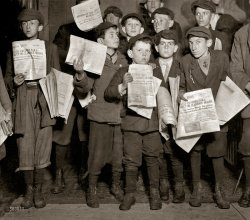
- Ready for Takeoff: 1912
- College Park, Maryland, 1912. "Aviation, Army. College Park aviation field, 2nd season. Capt. F.B. ...
Frederick Hennessy
Washington Post, Sep 12, 1912
It was announced by Capt. Frederick Hennessy, who is in charge ... school.
Washington Post, Oct 15, 1912
Capt. Frederick Hennessy, in charge of the hydroaeroplane ... Posted by Dave - 08/26/2012 - 11:44am -
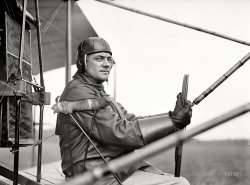
- Letterbox: 1912
- ... D.C. "Post Office Department. Motorcycle postman. 1912." S14 collects the mail. Harris & Ewing Collection glass negative. ... locks are produced at the same location as they were in 1912, at the Mail Equipment Shops, 2135 Fifth Street, NE, Washington, DC. ... Posted by Dave - 04/06/2013 - 11:56am -
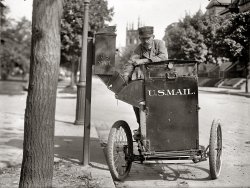
- Harvard Underground: 1912
- Cambridge, Massachusetts, circa 1912. "Entrance to subway, Harvard Square." 8x10 inch dry plate glass negative, ...
[Very common. - Dave]
The No. 1 bus circa 1912 The trolley on the right states "Harvard Square" on top then "Dudley ... which to pick.
Plate Number 7525 According to the 1912 New England Automobile Register, Massachusetts license plate 7525 belonged ... Posted by Dave - 09/21/2011 - 2:09pm -
![Harvard Underground: 1912 Cambridge, Massachusetts, circa 1912. "Entrance to subway, Harvard Square." 8x10 inch dry plate glass negative, Detroit Publishing Company. View full size.
All God's Children got hatsIn all these early 20th century photos, every head gets a hat, even petite little goils got huge chapeaux. I am focusing now on the extreme right of the picture, under the Billings Apothecary sign, where one can see the back of a "beat cop" with the old timey, double-breasted police uniform and bobby-looking helmet, such as those seen in most old comedy movies when Buster Keaton and Charlie Chaplain would get in trouble. Do the east coast cities still have policemen who walk a beat on the city streets? I haven't been there in so long, I'm not sure they still do that. My Uncle was a Brooklyn policeman who walked a beat from 1936 through 1966 and also patrolled the l939 World's Fair in Queens, N.Y. I love living in the past (it is an escape) and thank you Shorpy for reigniting old memories so accurately. P.S. The lady crossing the street appears to be wearing two hats.
That's more like it - exorcismNice sunny day, faster shutter speed with plenty of activity - but no ghosts.
Harvard YardNancy says the brick arches to the left of the street car are the entrance to Harvard Yard.
Can anyone ID the cars?
The KioskHere is the inevitable Google Street View comparison, albeit from a slightly different angle (the traffic pattern in Harvard Square seems to have changed in the past 100 years):
View Larger Map
The subway station moved from this original location across the street; its headhouse is still there and referred to by natives as the "kiosk" although it's now occupied by the Out of Town News newsstand. When the Red Line was expanded past Harvard in the 1980s the entrance was moved from that headhouse to a clunky brick monstrosity about 50 feet away.
As you can see, the small wood frame house is still extant just next to the gate into Harvard Yard (behind/to the right of the headhouse), although I'm not sure about the tall building we can see beyond it. Now that space, roughly, is occupied by the Widener Library, which hadn't yet been built because it was named after an alum who sank with the Titanic 'round about this time.
The buildings you can see on the right side of Massachusetts Ave (aka Mass Ave) in the original were razed in the 1960s by Harvard to build a brutalist concrete monstrosity (are you sensing a theme here?) that now houses their health services for students, among other things.
Police headgearDuring the first part of the 20th century, most American police officers wore headgear in use during the latter part of the 19th century. The practice, at least with the Boston Police Department, was to wear the gray colored hats in the summer, then switch over to black during the winter months. The police officer shown in the photo was of course a member of the Cambridge Police Department.
Not so petite little goilThere, at the center of the portico. She's dressed like a child no more than eight or ten years old, and is carrying the baby dolls to prove it, but she's already bigger than some of the adult women in the photo. If that's her mom next to her, genuinely petite under her big hat, that's one little goil who must have taken after her great big dad.
ApothecaryThe Billings and Stover Apothecary seen at the right on Brattle Street persisted until 2002.
Right-Side DriverI notice that the car with the plate number 7525 has the steering wheel on the right-hand side. I wonder how common this was in those days.
[Very common. - Dave]
The No. 1 bus circa 1912The trolley on the right states "Harvard Square" on top then "Dudley Street transfer station" underneath. The name transfer station refers to the busy Dudley Square stop, which today services trains and buses and then referred to different trolley lines. Today this same (and extremely popular) route is serviced by the MBTA's route number one bus running from Harvard Square in Cambridge to Dudley Square in Roxbury. Many of the most popular modern bus routes in the Boston area were once trolleys.
Click n' ClackNary a sign (yet) of the Tappet Brothers!
113 Brattle StreetOut of sight around the gentle curve of Brattle Street exists the grand old structure once known as New Preparatory School. Run by the family Benshimol, all Harvard graduates, and principled by the patriarch Ernest, it was touted as a pre-school for those fixed on getting into those ivy covered halls. The other thing the school was famous for was hockey. I was neither headed for Harvard, nor played hockey, which kept my GPA pretty low. I did graduate. I did wear the blue blazer with the three gold buttons, and sport the blue and gold school tie. I did go to college.
Ernie B. ran his classes with a hockey stick, a broadsword, a tipped foil, and a baseball bat. All used for effect, embarrassment, and pain as his students would stand on the great table to recite whatever he wanted as he slapped the table, poked the student and smacked the students butt if they failed to provide, all the while yelling (like a hockey coach) over and over what he expected, without giving away the answer.
The building is now occupied by a company that seems to hunt heads for the dark side. Harvard provides plenty of herd from which to pick.
Plate Number 7525According to the 1912 New England Automobile Register, Massachusetts license plate 7525 belonged to Arthur Fairbanks, 26 Elmwood St., Cambridge, for his 22 h.p. Buick, engine number 1030. I would guess that the man behind the wheel is Mr. Fairbanks.
Nearly all American cars except the Model T Ford had right-hand drive up to 1912; most switched for the 1913 model year. There were a few stragglers, notably Pierce-Arrow, which did not make the switch until the 1920s.
(The Gallery, Cars, Trucks, Buses, DPC, Streetcars)](https://www.shorpy.com/files/images/SHORPY_4a24400a.thumbnail.jpg)
- Snellenburg's: 1912
- 1912. "City Hall and Market Street west from 11th, Philadelphia." With a ...
Hall of Fame The 1912 NL Phillies had a losing 73-79 season finishing in 5th place, 30 1/2 ... Posted by Dave - 07/09/2018 - 2:59pm -
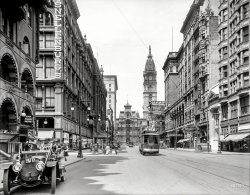
- Mysterious Fire: 1912
- May 24, 1912. "R.P. Andrews fire, 628 D Street N.W." Washington Post headline: ... Posted by Dave - 08/07/2012 - 12:11pm -
![Mysterious Fire: 1912 May 24, 1912. "R.P. Andrews fire, 628 D Street N.W." Washington Post headline: "Mysterious Fire in R.P. Andrews Warehouse Does $75,000 Damage." The item goes on to say that the cause was thought to have been "wires connected with the electric elevator." National Photo Company glass negative. View full size.
Enough signsThank goodness there were enough signs so the firemen could find this obscure little business. I also think being next to the buffet helped.
Master detectives.Paper, paper, paper, stationery, stationery, paper, paper paper, and twine. Plus faulty wiring. And the place goes up in flames? A complete and utter mystery!
The "P" in "R.P. Andrews"......stand for Primatech, of course. This was a Company raid on an early group of Heroes led by Hosmer Higginbotham, whose superpower was to reverse the sizes of the wheels on pennyfarthing bicycles.
$75 todayAdjusted for inflation, that's $1.6 MILLION dollars today!
[Or would it be more like a billion? - Dave]
When the fire's out...Stop! Hammer time!
More fuel for the firePaint supplies and toilet paper. Those combustibles wouldn't have slowed things down. Both are advertised on the windows.
[The sign says "Printers' Supplies." - Dave]
Modesty PermitsNote the mention of TP in the window of R.P. Andrews' shop. I guess our Edwardian forefathers weren't as modest as I thought. I'm still kind of shy about carrying toilet paper home in my shopping bundle for all to see.
Hmm.Anyone know what the R.P. Andrews warehouse contained? I'm stumped...
(The Gallery, D.C., Fires, Floods etc., Natl Photo, Stores & Markets)](https://www.shorpy.com/files/images/31616u.thumbnail.jpg)
- Lake Drive: 1912
- The Detroit suburbs circa 1912. "Lake Drive -- Grosse Pointe, Michigan." 8x10 inch dry plate glass ... it until they cross Alter Road.
Porcelain Plates 1912 Michigan license tags had black letters on an orange background, and the ... enough room for a house between the road and the lake. In 1912, the GPs were just becoming attractive to auto barons looking for an ... Posted by Dave - 06/17/2023 - 2:13pm -
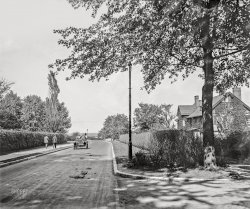
- Smoke and Mirrors: 1912
- Toledo, Ohio, circa 1912. "White Star steamer Owana leaving for Detroit." 8x10 inch dry plate ... Posted by Dave - 08/01/2012 - 1:41pm -
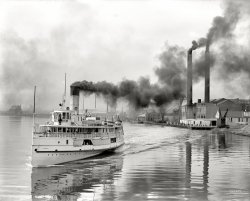
- Everywhere a Sign: 1912
- February 23, 1912. "Three-ton electric sign blown into Broadway." Our second look at the ... Posted by Dave - 09/12/2011 - 2:26pm -
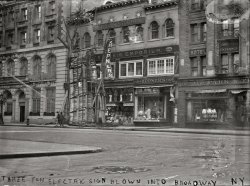
- Come Fly With Me: 1912
- December 1912. "Auto polo," somewhere in New York. It looks a little risky to me. 5x7 ...
A new sport N.Y. Times article from 1912 on an auto polo exhibition at Madison Square Garden. It notes the high ... I'm wondering if this is Ebbetts Field, which was built in 1912. I guess more likely the Polo Grounds. Is there anyone out there who can ... Posted by Dave - 09/12/2011 - 2:40pm -
![Come Fly With Me: 1912 December 1912. "Auto polo," somewhere in New York. It looks a little risky to me. 5x7 glass negative, George Grantham Bain Collection. View full size.
And a movie!The game in action!
Perfect candidatesfor the Darwin Awards? Yeesh~!
Best reason to chant "Get a horse" yetForerunner of the demolition derby?
Auto Polo's Young DaredevilsFrom the the Kansas City Star Magazine - November 14, 1971
Few sports were ever devised, I think, with the thrills and spills, the collisions and rollovers, the spectator excitement of a game played in Kansas in Model T Fords nearly 60 years ago.
The name of the game was auto polo. Continue reading
Risky?I'll see your "risky" and raise you "stoopid!" But it does look exciting, and boys will be boys. Was I born too late or too bright?
That's EntertainmentIt's like bumper cars, only without the bumpers.
Look at 'em go!This may well be the best action photo on the site.
Ten, Nine, Eight...Countdown to Farkitization.
A new sportN.Y. Times article from 1912 on an auto polo exhibition at Madison Square Garden. It notes the high injury rate of the sport!
Zap. Pow!Now these people know what an EXTREME sport really is.
Looney Tunes PhysicsIf the forward motion of the headfirst tumbler coincides perfecty with the downward arc of the upraised mallet, then the next thing we'll hear is "boi-oi-oi-oi-ing" followed immediately by birds chirping.
Safety LastI can't imagine why this never caught on.
Ebbetts Field???From the angle of the bleachers, I'm wondering if this is Ebbetts Field, which was built in 1912. I guess more likely the Polo Grounds. Is there anyone out there who can make an educated guess? Stadium pictures like this make me nuts. (In a good way.)
Maybe Hilltop ParkEbbets Field opened in 1913 and was under construction until very close to Opening Day. This photo might have been taken at Hilltop Park, where the Yankees (then the Highlanders) played until moving into the Polo Grounds in 1913.
Mack Sennet, where are you?This looks like something out of Keystone Kops! Yes, before somebody yells at me, the word "Kops" was really, REALLY spelled with a "k".
Posed?I have a feeling this may not be quite so much of an action shot.
Something - perhaps a prop - has been painted out behind the left-hand car's rear wheel. And there's definitely a support of some kind holding up the other car. Looks like a lump of timber about six inches across.
Looks like the two blurred figures took a dive for the camera.
Still quite mad, though.
[One of the cars in the other "action" shot from 1912 is propped up at an angle, too. - Dave]
Hilltop ParkIt's Hilltop Park. You can line up the wall, buildings, and even the advertisements with this photo:
(The Gallery, Cars, Trucks, Buses, G.G. Bain, NYC, Sports)](https://www.shorpy.com/files/images/11113u.thumbnail.jpg)
- Forbes Field: 1912
- Pittsburgh circa 1912. "Entrance to Forbes Field." Grandstand admission 75 cents. 8x10 inch dry ... a World Series, which would mean 1909 is more likely than 1912.
[1909 flags wouldn't have 48 stars. - Dave]
Child Labor I ... been a Lewis Hine shot.
Flag Display Days May 31, 1912, Decoration Day, later known as Memorial Day, The Pirates played the ... Posted by Dave - 07/23/2012 - 6:48pm -
![Forbes Field: 1912 Pittsburgh circa 1912. "Entrance to Forbes Field." Grandstand admission 75 cents. 8x10 inch dry plate glass negative, Detroit Publishing Company. View full size.
Watch behind you!It's sometimes amazing to look at these old photos and wonder about how safety standards 100 years ago were so different. There are folks sitting on the second tier, one guy on what looks like a crate -- with no support to prevent anyone sitting or standing at the rear from falling with just one simple mistake. Absolutely remarkable to see that.
1909?The flags make me think it's during a World Series, which would mean 1909 is more likely than 1912.
[1909 flags wouldn't have 48 stars. - Dave]
Child LaborI spot 3 young vendors in the crowd. This could have been a Lewis Hine shot.
Flag Display DaysMay 31, 1912, Decoration Day, later known as Memorial Day, The Pirates played the Cincinnati Reds at home with a 6-2 win.
Fourth of July 1912, Pittsburgh played The Cincinnati Reds again at Forbes Field and won the game 3-2.
I tried to find Honus Wagner in the crowd but figured he was already on the field.
Ancestrial SlobsOur Ancestors weren't too concerned with littering. Those gutters are filled with trash!
50 years ago this monthBill Mazeroski hit the only World Series Game Seven walk-off home run at Forbes Field to lead the Pirates to victory against the Yankees.
75 centsAdjusted for inflation, the same ticket would cost you around $17 today. Interestingly, current grandstand tickets for Pirate games now cost anywhere from $9 to $16.
Never a No-NoThere was never a single no-hitter thrown in Forbes Field in the 61 seasons it existed. It was also the site of Babe Ruth's last 3 home runs (May 25, 1935), when he played for the Boston Braves.
__field Motor Co.What is the name of the Motor Company in the background?
[Bellefield Motor Co. - Dave]
Dignified PatronsA refreshing scene, so different from modern sporting events. Note the complete absence of team-logo knockoff merchandise. There may be a heckler or two in the crowd, but the drunken, swearing fans of today would be tossed from that stadium tout de suite.
FFFans just gathered at the site of the former Forbes last week to listen to a rebroadcast of Bill Mazeroski's series winning home run on its 50th anniversary. The site is currently part of The University of Pittsburgh campus, and home plate is still on the ground (covered in protective plexi) in the floor of the building that takes up most of the space. (When I attended a few years back, legend had it that they had to move it a few feet though, otherwise it would have been in a closet.) Finally, if you're ever in Pittsburgh, check out the Miniature Railroad and Village at Carnegie Science Center -- they made an exquisitely detailed to-scale replica of Forbes Field, and used dust from a donated original brick to make the infield!
Boy with BundleBoy to the right has a bundle of sticklike things. Assume he is selling them, but what the heck are they?
[Rattan balloon sticks or pennant canes. - Dave]
Flags & Bunting & new constructionEvery June or July in the early years of Forbes Field, the Pittsburg Press hosted the Tri-State Track and Field Meet there. News accounts describe the stadium as "bedecked by flags and bunting" for the event. In 1912 there was considerable new construction. The entire playing field was relocated to move the foul line relative to the left-field bleachers. The first-tier seating was also revised, which entailed the pouring of concrete and installation of new railings. The first tier would be what looks like the second story from the outside of the stadium.
[A few tricolor flags here. They look French or Italian. - Dave]
Auto-palooza!I love the perspective of the long line of brass-era automobiles all lined up for us in this photo, and the contrast of the one lone horse and buggy. Also, there seems to be a teenager sitting in the car closest to us, but I can't tell if he's behind the wheel or not. He's probably as anxious to get his license as the teenaged boys of today - some things never change! One of my favorite photos on Shorpy. Thanks Dave!
Precarious PerchesNote that there is a wall to keep you from falling. The crate sitters are on top of the wall.
The Fine PrintEach of the the large shields has lists in each of the white columns. Are these "memorial," "ceremonial"? I could make several guesses. Any insight?
More Flag MinutiaeSome tricolor flags may be Pittsburgh City flags. The flag on the top ledge above the man on the crate appears to be a City of Pittsburgh flag. Two flags above the glass archway to the far right bottom of the photo may be city flags also.
Lots going on here!Such as the kid with the papers in the foreground...I can almost hear him saying to the other kid, "G'wan, get outta here ... I'm woikin' dis side of da street!" And, as for the trash in the gutters, no worse than you'd see in the parking lot of one of today's major stadiums after a big game. And speaking of parking lots, how about the one in this photo? A single row that stretches around the stadium. Shouldn't have any problem finding your car after the game. And the way the fans are dressed is great. No face painters or painted shirtless beer swillers either. Oh, and you guys up there on the beer crates ... be careful!
Game Day AttireLast weekend, I went to a college football game. I wore tennis shoes, jeans, and a cute little t-shirt with my team's colors and was very comfortable. I'm just trying to wrap my head around what it would be like to attend a sporting event dressed like the woman in the lower left corner-- a voluminous, light-colored dress and that *enormous* hat. (I also love the hat the woman in between the archways is sporting!) Of course, they would have been used to wearing that amount of clothing wherever they went, but still-- you go, ladies.
What a Ballpark!I'm a native here but alas never had the chance to see a game in this famous park. I have a friend though a little older than I who has an actual seat from Forbes Field. A collector of sorts, he's now set his sights on a seat from the now defunct Mellon Arena.
Is This Forbes Field???Beyond Forbes Field's left field was the Carnegie Library Building which was built in 1895. Where is the library building? Because of a park and the Carnegie Library there were no houses beyond left field. What park is this???
re: Is this ForbesHere's another picture of Forbes Field. Sure looks the same to me.
Grandstand seatsWhen I was a kid my dad took me to many Pirate games at Forbes Field. He started taking me in 1958 when Ted Kluszewski was first traded to the Pirates from Cincinnati. At that time good reserve seat tickets were $2.50 and bleacher seats were 50¢.
(The Gallery, Cars, Trucks, Buses, DPC, Pittsburgh, Sports)](https://www.shorpy.com/files/images/4a23349a.thumbnail.jpg)
- Central Square: 1912
- Cambridge, Massachusetts, circa 1912. "Central Square and Massachusetts Avenue." 8x10 inch dry plate glass ... corner. Interesting to see that the Oak Grove Grocery in 1912 sat in the same spot (albeit in a new building) as Store 24 in the 1990s ... Posted by Dave - 02/08/2023 - 6:39pm -
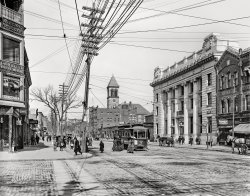
- What Goes Around: 1912
- The year is 1912 and the place is Detroit. What's going on here? View full size.
... LP gas that we use now). The original caption: "April 4, 1912. Foundation for gas holder, Detroit City Gas Company."
Happy ... It seems to small for an arena or a test track, even at 1912 speeds.
Gas holder? My guess - building the bottom of a gas holder ... Posted by Dave - 08/09/2012 - 10:50pm -
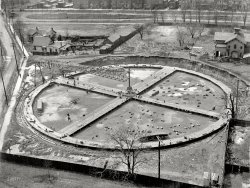
- On the Avenue: 1912
- New York circa 1912. "Fifth Avenue south from Thirty-Sixth Street." 8x10 inch dry plate glass ... "On The Avenue Of Golden Dreams" Curbed is a 1912 Pierce-Arrow Model 36 Vestibule Town Car, the chauffeur alertly trying to ... Posted by Dave - 04/17/2022 - 10:26am -
![On the Avenue: 1912 New York circa 1912. "Fifth Avenue south from Thirty-Sixth Street." 8x10 inch dry plate glass negative, Detroit Publishing Company. View full size.
In your Easter bonnet, with all the frills upon it,
You'll be the grandest lady in the Easter Parade.
I'll be all in clover and when they look you over,
I'll be the proudest fellow in the Easter Parade.
On the avenue, Fifth Avenue, the photographers will snap us,
And you'll find that you're in the rotogravure.
Oh, I could write a sonnet about your Easter bonnet,
And of the girl I'm taking to the Easter Parade.
"Smile and show your dimple"A little-known fact about Irving Berlin's famous song "Easter Parade" is that those are not the melody's original words. The tune was composed in 1917 as "Smile and Show Your Dimple" to cheer the girls whose boyfriends had gone off to fight World War I. Berlin revised it in 1933 with the Easter lyrics for the Broadway musical revue "As Thousands Cheer."
Their great granddaughters will wear torn jeansFifth Avenue divides the numbered streets into east and west addresses. If you're looking south down Fifth Avenue and standing on this side of Fifth you're on East 36th Street, not West.
To the immediate left, these beautifully outfitted ladies are strolling past 381 and 383 Fifth Ave; two buildings that appear to be one.
"On The Avenue Of Golden Dreams"Curbed is a 1912 Pierce-Arrow Model 36 Vestibule Town Car, the chauffeur alertly trying to catch an early glimpse of his returning employer. Even the hack pony couldn't resist a sideways glance in the direction of the magnificent horseless carriage. "Happy Easter to everyone who celebrates it."
https://www.bonhams.com/auctions/21223/lot/518/?category=list
Steering wheels?Are the steering wheels on the right side?
Or is this image reversed?
[Is that license plate reversed? The signs on the storefronts? - Dave]
Double visionViewers will note at least one -- the other is obscured -- of the double deck buses the Avenue was known for. Assuredly one of the first city bus lines in the U.S. But even the most knowledgeable will be hard pressed to identify the builder (and not just because it's mostly hidden): the Fifth Avenue Coach Co. were DIYers.
Word of the Day"And you'll find that you're
in the rotogravure."
I was just thinking about that line this morning. Is there anyone who didn't first encounter the word "rotogravure" in this song?
A "few" changes ...Remarkable to me is the fact the building on the west side of the street, with the arches, still stands. A bit farther down is a building with columns and a flag flying from its roof. That building still stands though it no longer has columns and is now taller having undergone massive reconstruction, The building that follows it, with the onion dome at the corner is the original Waldorf-Astoria Hotel. It was demolished and moved to Park Avenue. The Empire State Building now stands on the site, and was constructed in thirteen months including the time taken to demolish the old Waldorf. A bit past the Waldorf, a flag flies from the approximate location of a new tower about to be built that will be almost as high as the ESB.
+96Below is the same view from November of 2008.
(The Gallery, Cars, Trucks, Buses, DPC, NYC)](https://www.shorpy.com/files/images/SHORPY-4a25585a2.thumbnail.jpg)























